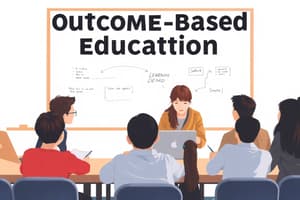Podcast
Questions and Answers
What is the primary purpose of summative assessments?
What is the primary purpose of summative assessments?
- To provide ongoing feedback during instruction
- To assist students in identifying their learning strategies
- To check what has been learned to date (correct)
- To gather evidence for monitoring learning
Which assessment method is classified as a form of summative assessment?
Which assessment method is classified as a form of summative assessment?
- Peer assessment
- Self-assessment
- Portfolios (correct)
- Descriptive feedback
Assessment as learning primarily focuses on which of the following?
Assessment as learning primarily focuses on which of the following?
- Reporting achievement grades to external stakeholders
- Encouraging students to assess their own understanding (correct)
- Providing immediate feedback from the instructor
- Facilitating teacher-directed evaluations
In what way is formative assessment different from summative assessment?
In what way is formative assessment different from summative assessment?
Which of the following strategies is used in Assessment as Learning?
Which of the following strategies is used in Assessment as Learning?
What is the primary purpose of the Table of Specifications (TOS) in test construction?
What is the primary purpose of the Table of Specifications (TOS) in test construction?
What is a characteristic of summative assessments?
What is a characteristic of summative assessments?
What role do teachers play in Assessment as Learning?
What role do teachers play in Assessment as Learning?
How many items does it suggest to draft if five recall level items are needed in the final test?
How many items does it suggest to draft if five recall level items are needed in the final test?
Which assessment type is NOT characterized by continuous feedback?
Which assessment type is NOT characterized by continuous feedback?
What are the characteristics assessed during the try-out of the test draft?
What are the characteristics assessed during the try-out of the test draft?
Why might teachers avoid using essay examinations in practice?
Why might teachers avoid using essay examinations in practice?
What should a teacher do to construct a comprehensive test?
What should a teacher do to construct a comprehensive test?
What is a critical aspect of item analysis during the test try-out?
What is a critical aspect of item analysis during the test try-out?
What is one common error test makers make without a TOS?
What is one common error test makers make without a TOS?
What is a suggested benefit of using a TOS in constructing a test?
What is a suggested benefit of using a TOS in constructing a test?
What is a key principle to avoid in multiple-choice questions?
What is a key principle to avoid in multiple-choice questions?
How should a question be structured to ensure clarity?
How should a question be structured to ensure clarity?
When is it appropriate to use the 'none of the above' option?
When is it appropriate to use the 'none of the above' option?
What is the purpose of distractors in a multiple-choice test?
What is the purpose of distractors in a multiple-choice test?
Which approach can make a multiple-choice question more difficult?
Which approach can make a multiple-choice question more difficult?
Which of the following is a recommended guideline for writing multiple-choice questions?
Which of the following is a recommended guideline for writing multiple-choice questions?
What should the focus be when determining the level of difficulty in a multiple-choice question?
What should the focus be when determining the level of difficulty in a multiple-choice question?
Why should the use of 'all of the above' be avoided?
Why should the use of 'all of the above' be avoided?
Which of the following best illustrates a non-relevant source of difficulty?
Which of the following best illustrates a non-relevant source of difficulty?
Which of the following best describes a well-constructed multiple-choice question?
Which of the following best describes a well-constructed multiple-choice question?
What can happen if negatives or double negatives are used in a question's stem?
What can happen if negatives or double negatives are used in a question's stem?
What is the purpose of the 'Pair - Share - Critique' exercise?
What is the purpose of the 'Pair - Share - Critique' exercise?
What is one way to make a multiple-choice question more specific?
What is one way to make a multiple-choice question more specific?
What does packing a question in the stem achieve?
What does packing a question in the stem achieve?
Why is it important to avoid using complex or awkward word arrangements in multiple-choice items?
Why is it important to avoid using complex or awkward word arrangements in multiple-choice items?
What is a key feature of multiple-choice tests that allows testing of higher-order thinking skills?
What is a key feature of multiple-choice tests that allows testing of higher-order thinking skills?
What is a key characteristic of supply type tests?
What is a key characteristic of supply type tests?
What is an example of a completion type of test that assesses higher-order thinking?
What is an example of a completion type of test that assesses higher-order thinking?
What should be avoided when constructing a completion type test?
What should be avoided when constructing a completion type test?
In a completion type of test, which of the following is most likely to test recall skills?
In a completion type of test, which of the following is most likely to test recall skills?
What should instructions for an imperfect matching test include?
What should instructions for an imperfect matching test include?
What type of reasoning is primarily measured in completion type tests?
What type of reasoning is primarily measured in completion type tests?
Which of the following examples best illustrates a complex completion type question?
Which of the following examples best illustrates a complex completion type question?
What can supply type tests effectively assess?
What can supply type tests effectively assess?
What is the primary focus for grading essays according to the criteria?
What is the primary focus for grading essays according to the criteria?
What is the purpose of putting a time limit on essay tests?
What is the purpose of putting a time limit on essay tests?
Which grading technique helps maintain a uniform standard for judging answers?
Which grading technique helps maintain a uniform standard for judging answers?
Why should evaluators read answers without knowing the identities of the writers?
Why should evaluators read answers without knowing the identities of the writers?
What is one potential consequence of scoring all answers from one student before moving to the next?
What is one potential consequence of scoring all answers from one student before moving to the next?
What grading criterion is assigned extra points during evaluation?
What grading criterion is assigned extra points during evaluation?
What should the focus be for students when informed about grading criteria?
What should the focus be for students when informed about grading criteria?
What is an example of an evaluation practice mentioned for essay questions?
What is an example of an evaluation practice mentioned for essay questions?
Flashcards
Summative Assessments
Summative Assessments
Evaluations that check what students have learned at a specific point in time.
Formative Assessments
Formative Assessments
Evaluations that help students improve their learning process by providing feedback and guidance.
Assessment as Learning
Assessment as Learning
A type of assessment where students are actively involved in evaluating their own learning.
Assessment as Learning Strategies
Assessment as Learning Strategies
Signup and view all the flashcards
Peer Assessment
Peer Assessment
Signup and view all the flashcards
Self-Assessment
Self-Assessment
Signup and view all the flashcards
Timing of Assessment as Learning
Timing of Assessment as Learning
Signup and view all the flashcards
Strategies for Assessment as Learning
Strategies for Assessment as Learning
Signup and view all the flashcards
Table of Specifications (TOS)
Table of Specifications (TOS)
Signup and view all the flashcards
Recall Level
Recall Level
Signup and view all the flashcards
Item Analysis
Item Analysis
Signup and view all the flashcards
Test Try-out
Test Try-out
Signup and view all the flashcards
Objective Test
Objective Test
Signup and view all the flashcards
Multiple Choice
Multiple Choice
Signup and view all the flashcards
Matching
Matching
Signup and view all the flashcards
Essay
Essay
Signup and view all the flashcards
Grading Criteria in Essays
Grading Criteria in Essays
Signup and view all the flashcards
Grading by Question
Grading by Question
Signup and view all the flashcards
Halo Effect in Grading
Halo Effect in Grading
Signup and view all the flashcards
Anonymous Grading
Anonymous Grading
Signup and view all the flashcards
Multiple-Choice Test
Multiple-Choice Test
Signup and view all the flashcards
Supply Type Test
Supply Type Test
Signup and view all the flashcards
Stem
Stem
Signup and view all the flashcards
Supply Type Tests for Lower-Order Thinking
Supply Type Tests for Lower-Order Thinking
Signup and view all the flashcards
Options
Options
Signup and view all the flashcards
Completion Type Test
Completion Type Test
Signup and view all the flashcards
Distractors
Distractors
Signup and view all the flashcards
Completion Type Tests for Higher-Order Thinking
Completion Type Tests for Higher-Order Thinking
Signup and view all the flashcards
Avoid Over-Mutilated Sentences
Avoid Over-Mutilated Sentences
Signup and view all the flashcards
Avoid Unfamiliar Language
Avoid Unfamiliar Language
Signup and view all the flashcards
Provide Enough Clues
Provide Enough Clues
Signup and view all the flashcards
Avoid Vague Modifiers
Avoid Vague Modifiers
Signup and view all the flashcards
Avoid Complex Structures
Avoid Complex Structures
Signup and view all the flashcards
Completion Type Tests as a Measure of Higher-Order Thinking
Completion Type Tests as a Measure of Higher-Order Thinking
Signup and view all the flashcards
Avoid Negatives
Avoid Negatives
Signup and view all the flashcards
Avoid Non-Relevant Difficulty
Avoid Non-Relevant Difficulty
Signup and view all the flashcards
Pack the Question in the Stem
Pack the Question in the Stem
Signup and view all the flashcards
Use "None of the Above" Appropriately
Use "None of the Above" Appropriately
Signup and view all the flashcards
Careful with "All of the Above"
Careful with "All of the Above"
Signup and view all the flashcards
Use "None" and "All" Sparingly
Use "None" and "All" Sparingly
Signup and view all the flashcards
Control Difficulty with Homogeneity
Control Difficulty with Homogeneity
Signup and view all the flashcards
Write-Pair-Share-Critique
Write-Pair-Share-Critique
Signup and view all the flashcards
Collaborative Test Item Creation
Collaborative Test Item Creation
Signup and view all the flashcards
Study Notes
Shift of Educational Focus on Content
- Education comes from "educare and educere," meaning "draw out"
- Expresses the "burst version" of the student
- "Teacher is not the center, it is the students"
- Outcome-based education rejects traditional focus on what school provides. It focuses on students demonstrating they "know and are able to do" required outcomes.
Object-Based Education Matching Intention with Accomplishment
- Student-centered process
- Student learning outcomes (SLO)
- Faculty responsibility for teaching
- Faculty-driven process, successful if faculty follow integration
- Integration involves finding connections between: standards (competencies), methods/approach (based on standard), and assessment (based on standard)
- Learning output should be meaningful, related to creating improvement in instruction and assessment.
Establishment of Meaning
- Data from assessment for continuous improvement
- Correct answer analysis
- Grading/checking
- Recording summative/formative
- Summative assessments at end of lessons
- All assessments must be graded, but not all are recorded
DepEd Curriculum Guide
- Content Standard (knowing part)
- Performance Standard (doing part)
- Learning Objectives created from LC
Identification of Educational Objectives
- Educational objectives are the great goal of a subject
- Objectives are stated from the teacher's perspective (e.g., to develop, to provide, to inculcate)
Listing of Learning Outcomes
- Learning outcomes are active verbs.
- Good source of learning outcome statements is Bloom's Taxonomy
Bloom's Taxonomy
- Create, evaluate, analyze, apply, understand, remember
Cognitive, Psychomotor, and Affective Domains
- Cognitive: Knowledge, mental skills (e.g., remembering, understanding, applying, evaluating)
- Psychomotor (skills): Manual/physical skills from observing, imitating, to practicing, innovating, adapting
- Affective (attitude/emotions): From simplest behavior to most complex (receiving, responding, valuing, organizing, internalizing)
Outcome Assessment Procedure
- Enables teachers to determine the extent to which students achieve learning outcomes.
- Data gathered leads to selection of assessment tools
- Distinguished between Immediate Outcomes and Deferred Outcomes
Institutional, Program, and Course Outcomes
- Institutional: Statement of what graduates will become after graduation
- Program (degree-specific): Outcome statements for specific degrees
- Course: Indicates what students should be able to do after a specific course
Learning Outcomes
- Statement of what students can do after a topic or lesson ("doing").
- Important because it clarifies expectations, prepares for future lessons
- Statement of what students are expected to be able to do as a result of a learning activity
Educational Objectives
- Explains what students will learn and be able to accomplish by the end of instruction.
- Describes a specific behavior leading to the desired goal
Measurable Learning Outcomes
- Specific "do" statements
- Measurable ways to assess
- Attainable/reasonable goals for learning
- Relevant methods to demonstrate the achievement of the outcome
- Timeline set for the completion of the outcome
Three Major Components (John Dewey)
- What students will be able to do
- Conditions needed for accomplishment (rubrics)
- Performance standards (norms for evaluation)
Learning Objective (SMART)
- Specific, Measurable, Achievable, Relevant, Time-Bound
- Actionable statements about student learning
Measurement, Assessment, and Evaluation
- Measurement: Rules to assign numbers to objects (quantify characteristics)
- Assessment: Collection, evaluation, and use of information for teacher decisions
- Evaluation: Effectiveness of product, process, or progress in terms of objectives/values
Assessment (Classroom Assessment)
- Systematic process of determining educational objectives, gathering info, analyzing to make decisions (about programs, student progress, etc.)
- Multi-source info gathering and discussion is used to assess what students know/can do after educational experiences
- Use of this process leads to improving subsequent learning.
Formative and Summative Evaluation
- Formative, developmental, to improve student/teacher
- Summative, completion-based (grades)
- Purpose is to evaluate student achievement
- Helps teachers evaluate the effectiveness of their instructional procedures/processes
Use of Information: Formative/Summative
- Formative, helps teachers and students plan future instruction & learning to achieve goals
- Summative, helps to measure the attainment/outcome
- Learning outcomes clarify what students should be able to do
Times and Strategies for Assessment as Learning
- Ongoing during instruction (with teacher support/modeling)
- Metacognitive processes used for learning.
Domains of Learning
- DOMAIN I: Cognitive Domain (Knowledge)
- DOMAIN II: Affective Domain (Attitude)
- DOMAIN III: Psychomotor Domain (Skills)
Types of Paper-and-Pencil Tests
- True-False (binomial): Provides 2 options; correct answer should discriminate from guessing
- Matching: Homogeneous items matched; options for better comprehension
- Completion: Supply blanks in sentences
- Essay: Assess higher-order thinking skills; require organization of thoughts
Keys to Effective Question Construction
- Avoid vague wording
- Limit the scope or number of steps (Avoid confusing or multi-step questions)
- Match the testing style or format to the objective
- Use clear/precise vocabulary
Studying That Suits You
Use AI to generate personalized quizzes and flashcards to suit your learning preferences.




